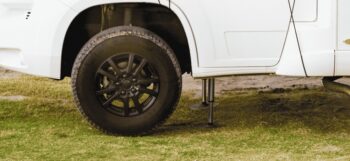Winter Tyres - do you know the mandatory requirements for travel in Europe?
In the UK, we aren’t accustomed to seasonal tyre changes. But if you're heading to Europe during the winter months, not only will you need to be prepared for treacherous road conditions, you’ll need to know the legal aspects of driving in Europe during the cold season.
Winter Tyres
Winter tyres are made from a different rubber compound to that of summer or all-season tyres, so they don’t harden when it’s cold. This, coupled with a deeper and more extensive groove pattern, provides increased tyre traction and therefore heightened safety.

It’s important to stress that winter tyres aren’t specifically designed for use on ice or snow, but use in temperatures below 7°c. Not only are they better for driving on snow and ice, but they’re also suitable for slushy and wet roads, providing improved road handling and reduced braking distances.
Winter tyres MUST be fitted in sets of four. Fitting just two will negatively affect both the balance and stability of your vehicle, which is something you’ll want to avoid.
Laws surrounding the use of winter tyres vary from country to country, and even region to region. The table below highlights where they are mandatory or advisory.*
Austria |
Winter tyres – Mandatory - 1st December to 1st March. Snow chains – Permitted. |
Belgium |
Winter, all-season or snow chains are mandatory. Snow chains and a shovel must be carried. |
Bulgaria |
Winter tyres – Mandatory in sleet, snow and ice. Minimum tread depth is 4mm. Snow chains – Required and a shovel must be carried. |
Croatia |
Winter tyres - Recommended. |
Cyprus |
Winter tyres – Mandatory, 1st November to 1st April. Minimum tread depth is 4mm. Snow chains – Mandatory, where instructed. |
Czech Republic |
Winter or all-season tyres - Recommended. Snow chains - Permitted. |
Denmark |
Winter tyres – Mandatory, 1st December to end February. Minimum tread depth is 3mm. |
Estonia |
Winter or all-season tyres – Mandatory, 1st December to end February. Tyres must feature M&S symbol. Minimum tread depth is 3mm. Snow chains - Permitted. |
Finland |
Winter tyres – Mandatory, drivers within 'snow zones' must have winter tyres and/or snow chains on their vehicle during the winter period from November 1 to March 31. Snow chains – Required, must be fitted to vehicles using snow-covered roads. (Should be carried and used as dictated by local signs or road conditions. Reduced speed limits may apply). |
France |
Winter tyres – Mandatory. Snow chains – Required (should be carried and used as dictated by local signs or road conditions. Reduced speed limits may apply). |
Germany |
Winter tyres - Non-compulsory, but tyres must be appropriate for winter conditions. Snow chains - Permitted. |
Greece |
Winter tyres - Non-compulsory. Snow chains – Must be carried, in case driving conditions deteriorate. |
Hungary |
Winter or all-season tyres – Mandatory, 1st November to 14th April. Note: Dates change so double-check. |
Italy |
Winter tyres – Mandatory, 1st December to 1st March. |
Ireland |
Winter tyres – Non-compulsory. Snow chains – Disallowed. |
Latvia |
Winter tyres - Mandatory, 1st November to 1st April. |
Lithuania |
Winter tyres – Non-compulsory. Minimum tread depth is 5mm. Note: tyres must be appropriate for winter conditions. |
Luxemburg |
Winter tyres - Non-compulsory. Snow chains - Must be carried, 15th November to 15th March. |
Malta |
Winter tyres – Non-compulsory. Snow chains – Disallowed. |
Netherlands |
Winter tyres – Non-compulsory. Snow chains – Disallowed. |
Poland |
Winter tyres - Non-compulsory, but tyres must be appropriate for winter conditions. Minimum tread depth is 2mm. |
Romania |
Winter tyres – Recommended but not compulsory. Note: vehicles not equipped to travel through snow and ice, and impede traffic flow, are liable to a fine. Snow chains - Required (should be carried and used as dictated by local signs or road conditions. Reduced speed limits may apply). |
Slovakia |
Winter tyres - Non-compulsory, but tyres carrying the M&S symbol must be used when compacted snow or ice is on the road. |
Slovenia |
Winter tyres – Mandatory, 15th November to 15th March. Snow chains and a shovel must be carried. |
Spain |
The use of winter tyres in Spain is regional. Traffic signs indicate where winter tyres or snow chains are compulsory. |
Sweden |
Winter tyres – Mandatory, 1st December to 31st March. Tyres must feature M&S symbol and have a minimum tread depth of 3mm. Snow chains – Recommended. |
Switzerland (Non – EU country, but a popular winter destination) |
Winter tyres – Non-compulsory across the whole country but tyres must be appropriate for winter conditions. Look out for traffic signs indicating where winter tyres or snow chains are mandatory. |
Snow chains - When to use them
Snow chains should only be used when the road surface is covered in a thick layer of snow or ice. Using them on clear or gritted roads brings with it the risk of damage to your vehicle, and the road.

Snow chains can be awkward to use, so make sure you practice fitting them at home before you travel. This will ensure that you know what you’re doing, should you suddenly run into adverse weather while you’re on your travels.
Be prepared for the worst
According to our breakdown insurance provider RAC, the most common causes of winter breakdowns are:
- Battery faults
- Tyre problems
- Engine management
- Mechanical failures
- Electrical faults
That’s why we offer breakdown cover from RAC to our motorhome insurance and car insurance customers, as a policy enhancement. RAC’s feature-packed policies can be upgraded for European travel, to provide peace of mind that you won’t be left stranded, should the worst happen.
For further information on RAC Motorhome breakdown cover or RAC Car breakdown cover visit lifesure.co.uk or give us a call on 01480 402 460.
*Please note: the information in the table shown was correct at the time of publication. However, laws do change in cases of extreme weather, so please check the requirements of the country you are going to, prior to travel. Data taken from https://www.uniroyal-tyres.com/car/service-knowledge/winter-tyres-mandatory/
Disclaimer: The sole purpose of this article is to provide guidance on the topic covered. This article is not intended to give legal advice and should not be relied upon. Neither should it be regarded as a comprehensive statement of the law and/or market practice in this area. We cannot guarantee the completeness or accuracy of the information contained in the aforementioned external link, which was live at the time of publication.











